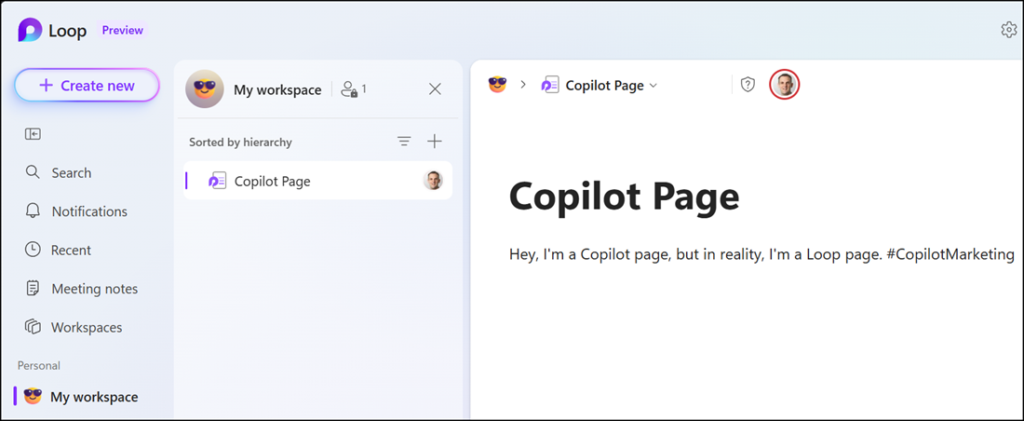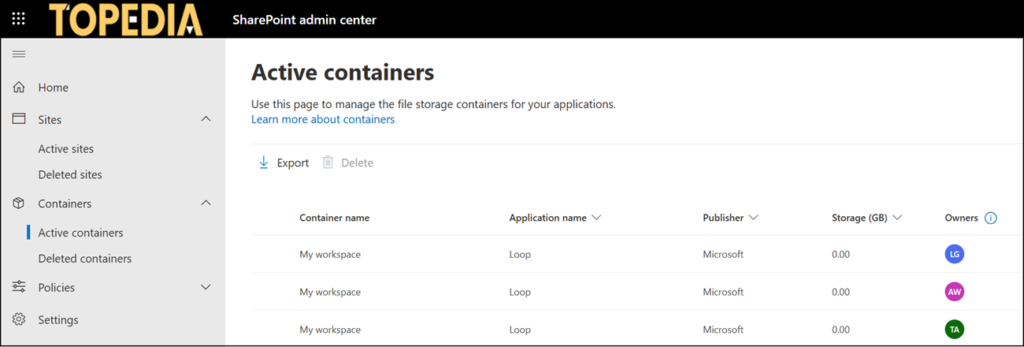Microsoft is adding a new Loop Workspace type: a Personal Workspace connected to a user account, similar to OneDrive. All accounts with a OneDrive get this new personal workspace container in Loop.
This new personal workspace is for Copilot Pages and designed to enhance user experience by offering a user-owned SharePoint Embedded container. The governance, lifecycle management, and compliance processes will align closely with those of the user’s OneDrive.
It is important to know that users now own two types of personal containers.
- Ideas Workspace (not new) is a shared SharePoint Embedded container, meaning the user can invite other members to the workspace. A SharePoint Embedded administrator can define a new owner if the Ideas workspace owner leaves the organization. Microsoft compares the Ideas workspace with a SharePoint Communication site.
Loop Ideas workspaces are tenant-managed like SharePoint Communication sites. They appear with existing Loop workspaces, with all features such as adding members and organizing pages

- Personal Workspace (new) is a user-owned SharePoint Embedded container, meaning users and administrators cannot invite other members to the workspace. If the user account is deleted in Entra ID, the user-owned container will be deleted too. A user-owned container is not transferable. Microsoft compares the Personal Workspace with a OneDrive site.
Content
Timeline
Rollout will start in February and should be completed by late March.
What users should know
Users see a new “My workspace” in the Personal section at loop.cloud.microsoft. If you don’t see it, wait one minute. The new container is provisioned when users visit Loop on the web after the rollout has been completed.
This workspace is the user-owned SharePoint Embedded container.

- Content in the workspace is private by default.
- Users cannot invite other accounts to that workspace, but they can share pages and components in the workspace.

- The workspace stores all Copilot Pages created by the user (in reality, Loop pages).
- The workspace and all the content will be deleted if the user account is deleted in Entra ID, similar to the OneDrive site collection.
What administrators should know
1) Administrators can prevent the new My Workspace container with a Cloud Policy, which also prevents users from creating a new shared workspace container. The policy also has no impact if the “My workspace” container has already been created for the user account.
Create Loop workspaces in Loop
This policy setting controls whether users can create Loop workspaces in the Loop web app, the Loop mobile apps, and the Microsoft 365 ecosystem.
- If you enable this policy setting, users can create Loop workspaces in the Loop app.
- If you disable this policy setting, users can’t create new Loop workspaces in the Loop app. The app will still boot and if the user has access to any content, it will be displayed and the user will maintain edit or view access to the content depending on their permissions.
- If you don’t configure this policy setting, users can create Loop workspaces in the Loop app.
2) The Personal Workspace will be provisioned after the feature has been enabled in your tenant and users open Loop on the web the next time. This triggers the system to create the workspace. Wait one minute, there is the new workspace. If the policy from Step 1 is disabled, the pre-provisioning process is prevented, and the workspace is not created.
3) It doesn’t matter whether an account is licensed for Loop, similar to Copilot Pages. Loop prepares the personal workspace container if the account has a OneDrive, even without the Loop service plan.
Microsoft notes:
If your organization has disabled the creation of OneDrive, these people in your organization won’t be able to create a Copilot Pages workspace.
4) SharePoint Embbeded administrators find the new workspaces in the SharePoint Admin Center at Containers > Active containers with the name “My workspace”.

5) SharePoint Embbeded administrators also find new workspaces with SharePoint Online PowerShell or PnP.PowerShell.

Currently, PowerShell includes no property related to the container type. According to the Roadmap, this type of information is planned.
The update enables SharePoint Embedded Administrators (SPE Admins) to identify the different kind of containers (user, tenant, and group) and the principal owner associated with the container.

Is it possible to add the My Workpace for users, but not allow them to create new shared workspaces?
Hi Chris, unfortunately, no, at least not yet. The bad thing is that, as Microsoft does not provide a public API for the Loop containers, you cannot pre-provision the container for user accounts (e.g., like OneDrive). Microsoft mentioned that a first edition of the Loop container API should be available in Q4/2024, but that never happened. They also do not respond to such questions.